Reference material: Japan Valve Manufacturers' Association
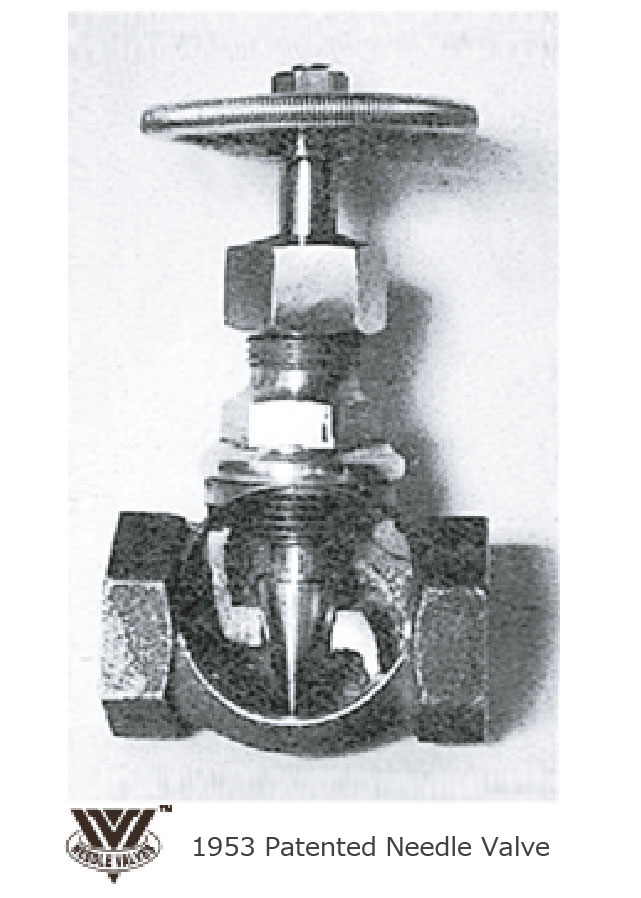
What are valves?
Valve is the general name for a device that can open and close a fluid pathway in order to stop, extract or allow fluids (gas and liquid) to pass through. The word valve can be used with a modifier in order to represent utility, form, or type. For example, general valve, ball valve, two-way valve, etc. Valves that mainly control the release and consumption of fluids are called plug valves such as faucets, gas taps, and fire hydrants.
History of Valves
One of the earliest valves may be a wooden cock-like device in the shape of a cone or cylinder that controlled fluid used in ancient Egypt circa 1,000 B.C. In ancient Rome, water pipes were laid in the houses of nobles, with cocks made of bronze. Metal valves have existed for more than 2,000 years.
Japan's First Metal Valves
In Japan, plugs have been used since ancient times for stopping up barrels of sake. The first metal valve in Japan is said to have been imported along with textile spinning machines and boilers in 1863. The manufacturing of valves began in 1885 when infrastructure for water works was constructed in Yokohama, along with the foundation of Tokyo Gas. Until the beginning of the Taisho era, the valves in demand were primarily bronze valves for the water works, gas, and textile industries. After World War I, as Japanese industry began to grow rapidly, iron and cast iron valves as well as other types of valves were in demand. At the end of World War II, production of valves began immediately as an important material for reconstruction. As industries flourished, a wide variety of valves were manufactured to satisfy the demands of a range of applications.
March 21: Valve Day
Valve Day was established to promote awareness of valves among the general public. We seek to improve the position of the valve industry in society by supporting a number of valve-related events. A date for the occasion was given careful consideration, and finally March 21 was selected as it marked the foundation of the Japan Valve Manufacturers Association in 1954.
Standard Valves
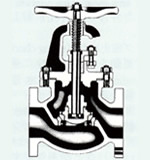
Globe Valve
Other names: Spherical valve
Globe valves have a spherical casing with the inlet and outlet positioned on a straight line, even though the fluid follows an S-shaped flow inside the casing. A plug at the end of the valve stem can be raised or lowered to open or shut the valve or to decrease or increase the pressure. These valves feature ease of control in closure and flow-control. Needle valves have a needle-shaped plug that allows for more precise control. Angle valves alter the direction of flow 90°. Bellows valves have a bellows construction and can be used for vacuums and toxic gas. These are all derivatives of globe valves.
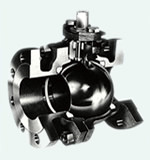
Ball Valve
Ball valves contain a spherical disk with a flow-hole bored through it. Rotating the disk by turning the valve stem regulates the flow. Ball valves may contain full sphere or half sphere valve disks. One of the advantages of a ball valve is the straight flow channel, resulting in minimal resistance when the disk is fully opened.
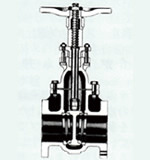
Gate Valve
Other names: Sluice valve
Gate valves are also known as partitioned valves because they use a partition to control the flow. A flat disk is raised or lowered to open or shut the valve. The various types of gate valves include wedged partition valves, parallel slide valves, double disk valves, and venturi port partition valves. An advantage of gate valves is the minimal fluid resistance; however, gate valves should be either fully opened or closed in order to avoid excessive vibration of the valve element at the midway point of closure.
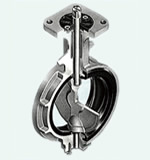
Butterfly Valve
A butterfly valve can isolate or regulate flow. The valve element that opens and closes the valve is in the form of a flat disk positioned in the center of the pipe. Passing through the disk is a rod connected to an actuator on the outside of the valve. Rotating the actuator turns the disk either parallel or perpendicular to the flow. Operation is therefore similar to that of a ball valve, which allows for quick shut off. Unlike the ball valve, the disk is always present within the flow, which necessarily induces a slight pressure drop regardless of valve position. Butterfly valves are generally favored because they are lower in cost than other valve designs and lighter in weight.
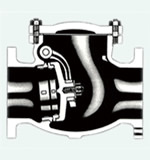
Check Valve
Check valves operate automatically. They require no handle or stem; rather they open at the point at which fluid reaches a specific “cracking pressure.” They are two-port valves with an inlet and outlet but their design specifically prevents back flow.
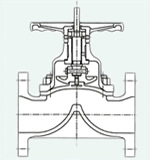
Diaphragm Valve
Other names: Membrane valve
A diaphragm valve flow channel is composed of a diaphragm and the valve casing, and flow rate is adjusted by pushing and separating the diaphragm against the inner surface of the valve casing. Since there is no packing, there are no external leaks, but the temperature and pressure are limited depending on the material of the diaphragm.
Specialized Valves
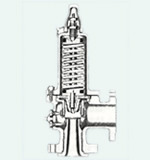
Safety Valve
Safety valves allow for the automatic release of fluid should pressure build up to dangerous levels. They are mainly used in steam and gas generators, pressure chambers and plumbing. When the inlet side pressure increases to a specified threshold, an automatic release of fluid occurs. Two types of safety valves include the spring safety valve and safety valve with the pilot function. There is a relief valve that works in the same way as these valves.
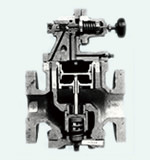
Regulating Valve
Regulating valves mechanically control flow volume, liquid level, and temperature when precision is not required. Threshold and deviation are set, and movement is actuated by pistons and diaphragms controlling the fluid pressure. Actuation energy is taken from the process flow and is therefore a form of self actuation. There are self-actuating and pilot driven valves. Most often the valve element is a ball type. Functionally speaking, safety valves and ball taps are considered regulating valves.
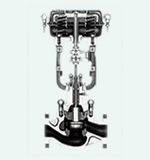
Control Valve
Control valves utilize external pneumatic or electronic actuators to fully or partially open or close the valve in response to specified control signals. Control valves may control not only fluid flow, but also pressure or temperature. Internally, a control valve may be a globe valve, angle valve, 3-way valve or ball valve; they are often differentiated by the number of valve seats. Flow properties such as linear equal percentage and quick opening are equally as important as CV values. The figure on the left is a sample of a pneumatic control valve with a single valve seat.
Faucets
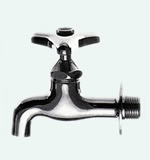
Single Faucet
A faucet is a device attached to plumbing, for flow control of hot and cold water, with no mixing functionalities. It is operated manually or automatically, and there are two types of faucets depending on the installation position.
Horizontal Faucet
Wall mounted faucet.
Vertical Faucet
Faucet generally used on washbasins, also known as a rotary faucet spout.
Mixer, Combination Faucet
This is a faucet that connects togehter both the water supply pipe and the hot water supply pipe. The mixing of hot and cold water is done inside the faucet. It is divided into different types; 2-handle, single lever, mixing and thermostat types. A 2-handle hot and cold water mixing faucet adjusts the temperature of the released water with a cold water handle and a hot water handle. A single-lever faucet is operated by a single lever which adjusts both the opening and closing, and the water temperature. A mixing faucet adjusts the temperature of the released water with one handle. A thermostat faucet sets the released water temperature in advance. A temperature adjustment handle automatically adjusts the mixing amount and supplies water at the set temperature, even when there are fluctuations in the pressure and temperature.
Stop, Stop Cock, Stop Valve, Curb Stop
These types of faucets are installed between the end of the water supply apparatus and the water supply pipe, and can adjust the flow rate or stop the flow of the water. These types of faucets are not frequently used.
Ball Tap (ball tap)
These are installed in water tanks, and by the buoyancy of the float, the water level inside the tank is maintained at a fixed level. When the water level lowers, the seat is opened and water is supplied. Water will continue to be supplied until the level rises to the set position, and the water supply is stopped.
Flush Valve, Flushometer Valve
These are used for flushing toilets; they supply the water used for sewage conveyance. A handle controls the release of water at the spout; the water stops automatically when a predetermined amount of water is obtained.
Fittings information
Fittings outline
Fittings are a piping component that connects valves to pipes or pipes together to extend them. They also have functions to easily put bends in pipe systems, distribute, expand, reduce, plug and connect or detach other valve equipment. In general, they use the same materials as valves. We will now explain the different types of fittings.
Fitting shapes
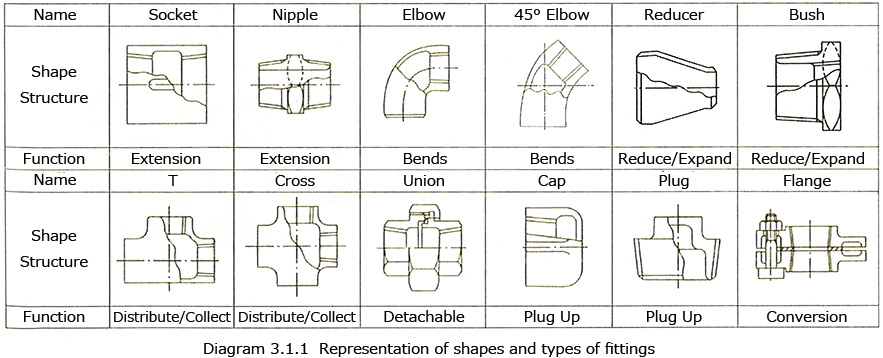
Basic types of fittings
Screw Type
There is a screw for piping at the end.
Union
Union fittings are a type of screw fitting.
Welded
There are butt weld and plug weld types.
Butt weld types: The ends are matched to the piping and welded together.
Plug weld types: The pipe is inserted into the end and welded.
Flange
Corresponding flanges are aligned together at the ends and a bolt and nut are inserted to connect them together.
Bite Type
A part of the fitting bites into the pipe to seal it off.

The general area related to water supply, drainage, cold and hot air supply and purification. A variety of valves are used. Anti-rust measures must be taken for valves made of metals while containment treatment is necessary for those made of copper-based materials.
Air-conditioning
The facilities that control temperature, humidity, volume, velocity, and purity of the air indoors. Valves are used for air ducts and hot and cold plumbing.
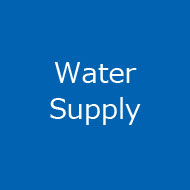
Water works and sewage treatment facilities. Municipal water is supplied by the water works. Valves are often installed below ground, and applications include control, seclusion, release, sluicing, reflux prevention, pipe conduit protection and sludge medicament injection.
Water Utilities
Hydrants, check valves, and butterfly valves. Many types of valves are used in everything from water purifying facilities to simple plumbing.
Water Supply Equipment
Within water supply equipment, partial hydrants, plugs, ball tap and check valves are used.
Fire Control Equipment
Fire Service Law requires hydrants to be differentiated into indoor and outdoor use.
Sewer
Water and sludge treatment. Valves are required to cope with foreign substances, sand, sludge content, and sulfuric and corrosive gases.

Thermal power generation and nuclear power generation are each categorized by their respective heat sources. Oil, coal, or natural gas in the former, or a nuclear reaction in the latter. Both generate electricity by rotating a turbine with high pressure and high temperature steam. Valves are used in regulating the steam and water cooling system.
Thermal Power Generation
Thermal power plants operate under conditions of high pressure and high temperature. The latest large scale coal-fired power plants operate at 538~566 °C. Operational steam pressure can reach 24 MPa. Therefore, operability under extreme conditions, material selection, adaptation to rapid temperature fluctuation, and maintaining air tightness are a few of the requirements for valves.
Nuclear Power Generation
High pressure and high temperature steam is generated in a nuclear reaction and is used to turn turbines in order to generate electricity. Valves help regulate the circulatory system, an important asset in nuclear power plants. Many valves are required for control over radioactive fluid, moderators, coolants, process steam, condensation, water supplies and cooling. Valves used in nuclear power generation plants undergo rigorous inspections, quality control, safety analysis, record checks and production checks for quality assurance.

The oil industry is categorized into oil drilling, petroleum refining, petrochemistry.
1.Valves and oil well drilling
Oil-well drilling occurs at depths of several hundred meters to several thousand meters below ground level, where the oil reservoirs are located. A flowing artesian state is achieved by drilling and then manipulating pressures. Valves are used in controlling the flow of oil at the wellhead.
2.Valves and Oil Refining
A variety of petroleum products are produced by distilling crude oil. Manufacturing processes include atmospheric distillation, distillation under reduced pressure, catalytic cracking, catalytic reforming, alkylation, desulfurization, and preparation. Processes occur between classes 125 to 4500, and valves utilize various materials, including: cast Iron, carbon steel, low-alloy steel, high-alloy steel, and low-temperature steel.
3.Valves and petrochemicals
Ethylene plants carry out a key process that produces intermediate materials for the petrochemical industry. Valves used in ethylene plants are similar to those in oil refineries, but they are required to follow much stricter standards for high temperature, extreme cold, high pressure, and corrosion-resistance. Many require specialized materials and specifications.
Characteristics of petroleum refining and petrochemical valves
Crude oil, heavy oil, volatile oil, acids and alkaline are hazardous fluids. Within the processes, valves may encounter extremes of cold and hot as well as flammable and explosive fluids and gases. Petroleum refining is a complex process and demands strict anti-corrosion standards. Because refineries are designed for long periods of operation, anti-corrosion is an essential specification for the valves. Due to the risks posed by disasters such as earthquakes and fires, valves for pipelines and tanks must be designed so as not to cause secondary disasters. In petroleum refining, there are common industry standards that specify the selection of materials in order to match the conditions under which valves will be used.

Raw natural gases are compressed and maintained at ultra-low temperatures; compressing gases to 1/60 allows for efficient transportation. A variety of valves are used in the handling of gases.
Industrial Gas Facilities
Industrial gases include natural gas (daily use), petroleum gas, and various chemical and specialized gases. Valves must be selected to match the particular materials and usage. Because industrial gases are flammable and explosive in nature, extra attention must be paid to valve selection, manufacturing, operation and safety. The High Pressure Gas Safety Law was promulgated to ensure safety standards are adhered to.

Shipbuilding
The category includes cargo ships, tankers, fishing vessels as well as fifty types of cruise ships. A ship’s piping system is complex, and valves are an essential part of this system that operates the ship. Valves are also used in support of the diverse cargo that ships may carry. Oil valves, ultra low temperature valves, and valves for chemicals are commonly used. Shipboard butterfly valves and gate valves as well as check valves, angle valves, globe valves and valves made of cast iron and cast bronze must be manufactured following the JIS Marine standards. To ensure that valves function safely, automatic devices used to confirm the reliability of the shipboard environment must be certified according to the standards set by a number of other classification societies.

Semiconductor manufacturing equipment
Semiconductor technology has given Japan great pride. The gas systems used in semiconductor manufacturing must maintain some of the highest levels of purity of any industry as even the tiniest of dust particles can be detrimental. Valves are designed in order to minimize or to prevent the generation and collection of extremely fine particles of dust.

Space exploration
In the field of space exploration, specialized valves are utilized for the control of rocket fuel and life support systems in outer space.

Food industry
Food industry valves have some particular requirements, namely that they do not contaminate the fluids intended for human consumption that will flow through them. Therefore, the process fluid valves used in the food industry must not only control the flow of fluids but be free of any harmful chemicals or other contaminants. Valves must also be designed so that they inhibit bacterial growth. A bevel seat formula is used to ensure that end connections are designed for easy assembly and disassembly with a clamp.
Paper industry
Utilizing variety of fluids, Papermaking is an industry that utilizes a wide range of fluids in one of the most complex production processes. Valves are required to withstand the slurries, which can be highly corrosive.
Regional air conditioning
Regional air conditioning systems involve a plant that supplies hot or cold steam heat to buildings. The general purpose and automatic control valves that are used require high durability and performance.
Waste incinerator
As measures for reducing waste (especially in landfills) become more common, waste incinerators are being built. They require a number of general purpose valves.
Chemicals industry
The chemical industry utilizes fluids that are highly corrosive and extremely variable in pressure (from vacuum to ultra-high) and in temperature. Piping is often complex and in frequent contact with corrosive materials. When selecting valves, operators must consider the corrosiveness of the process fluids and gases and weigh the available anti-corrosive properties of the valves against economic considerations.
